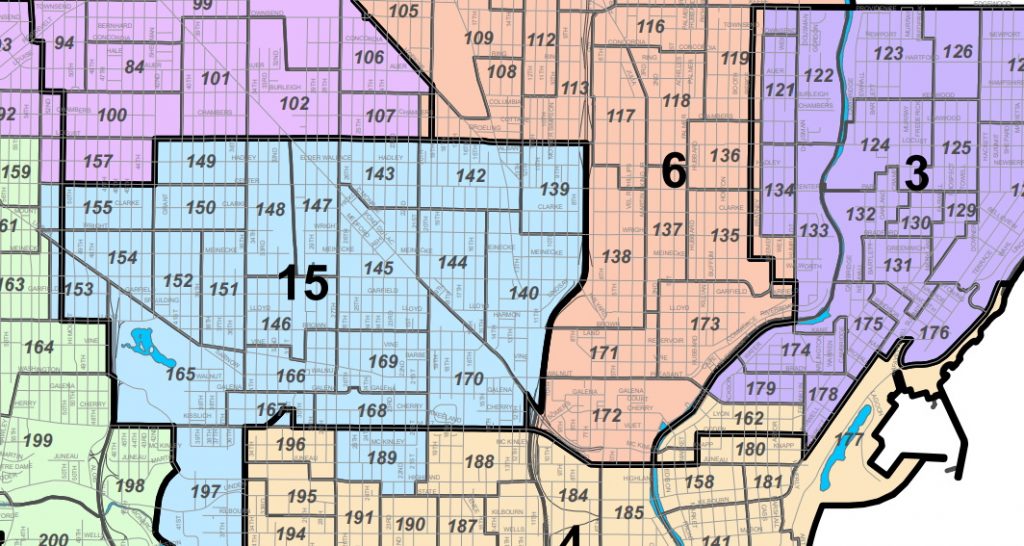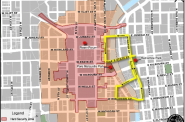Council Halts Redistricting After Latino Pushback
After approving a map in November, council rejects it, to allow more community feedback.
The Milwaukee Common Council was nearly unanimous in November when it voted to approve a new district map. Now it’s done an about-face and halted the process.
On Tuesday, the council voted unanimously to suspend the map and give members one more month to weigh in.
“I thank you from the bottom of my heart for simply listening,” said Alderwoman JoCasta Zamarripa, the lone member to vote against the original plan, to her colleagues on Tuesday morning. She praised the coalition for driving awareness of the issue.
Zamarripa said she understood the council was originally acting quickly to deliver the district map shortly after the ward map in an attempt to comply with the traditional redistricting process. The timing of the city’s redistricting effort, described as a “warp speed” process, was largely out of its control after federal, state and county delays.
But in Barrett’s veto letter, he said the City Attorney’s Office advised him that the council’s adoption of new maps by Jan. 18 “is adequate and will not pose challenges to other jurisdictions, nor interfere with elections.” The ward map will be used in the spring elections, but the district map would not be used until 2024.
“I think the process we are going through now is greater than redistricting,” said Alderman Ashanti Hamilton who led the council’s original effort. “This is something that we should do if we are given the extra time to do.”
The city is now 39.3% Black, 32.3% white, 20.1% Hispanic and 5.6% Asian. When considering only the voting age population, the city is 38.6% white, 36.1% Black, 17.6% Hispanic and 5.1% Asian. The Hispanic population of the city has grown in recent decades while the city’s total population has shrunk.
The council adopted 15 districts that maintain the balance of six Black majority districts, two Hispanic districts and five white districts of which two are being described as Hispanic “influence” districts. There is no legal definition for an “influence” district, but the council is informally defining it as a 25% voting bloc. Two districts have no racial or ethnic majority.
Voces would like to see the far south-side 13th district, currently represented by Ald. Scott Spiker and one of the two influence districts, redrawn in a way that it thinks will cause it to have a majority Hispanic population within the decade. It produced 10 different maps which would increase the Hispanic population, but none of which would give it a Hispanic majority voting-age population immediately.
The other influence district is the 14th council district, dominated by the Bay View neighborhood. The resulting Hispanic voting-age populations for the 13th and 14th districts were 25.6% and 28.1%, with white voting-age populations of 57.4% and 62.4%.
Spiker said he supported giving the community more time to consider options. “I see no harm in slowing things down,” he said. Spiker, as did Zamarripa, previously said he struggled to draw a third Hispanic majority district without diluting the voting power of the existing two majority districts.
“An appearance of impropriety in a public setting is just as bad as impropriety. I do not believe there was an impropriety,” he said. “I believe Alderman Hamilton ran a very good process and the Legislative Reference Bureau worked tirelessly.”
Spiker said his goal is to represent a “multi-ethnic, multi-racial fully diverse district.” Following predecessor Terry Witkowski, Spiker has maintained the Garden District branding. “I would be remiss if I didn’t mention my growing Middle Eastern North African Indian Subcontinent Muslim community.”
A new process for community feedback is expected to be announced. The full council is scheduled to meet again on Jan. 18.
The council adopted a new ward map on Nov. 17 which will impact where and with whom residents vote beginning with the Spring 2022 elections. Any new district map also needs to follow the lines set forth by the wards. Barrett signed the ward map into law.
The new district map will go into effect for the 2024 spring elections for all 15 council seats. Any special election occurring before that time, under state law, would occur with new wards, but under the prior district lines. The election commission would need to accommodate or restrict voters in the new, redrawn wards so that those voting align with those eligible under the prior districts.
The terms Latino and Hispanic were used interchangeably in this piece to represent the comments of a speaker or the wording of a document.
Maps and Statistics
- Barrett Veto Letter
- Voces-Petering Map Options
- Voces Original Concept Map
- Adopted District Map – Detailed
- Adopted District Map – 11×17
- Adopted District Map Demographics
- Adopted 2021 City Ward Map
- 2012 Ward Map
- 2012 Common Council Districts
- 2000 to 2010 Population Change by Aldermanic District
- 2010 to 2020 Population Change by Aldermanic District
- 2020 Population Change by Wards
- 2020 Aldermanic District Demographics
If you think stories like this are important, become a member of Urban Milwaukee and help support real, independent journalism. Plus you get some cool added benefits.
More about the Milwaukee County redistricting process
- Op Ed: Muslim Community Needs Representation - Janan Najeeb - Jan 29th, 2022
- City Hall: Council Ends Redistricting With Anger, Tears - Jeramey Jannene - Jan 18th, 2022
- Statement from Milwaukee Mayor Cavalier Johnson - Mayor Cavalier Johnson - Jan 18th, 2022
- City Hall: Latino Leaders Could Sue Over Redistricting - Jeramey Jannene - Jan 14th, 2022
- Latinx Leaders Condemn Common Council’s Refusal to Draw New Districts Reflecting Dramatic Growth of Latinx Population; Demand Second Legal Opinion - Voces de la Frontera - Jan 14th, 2022
- Voces de la Frontera Statement on Redistricting Decision - Voces de la Frontera - Jan 11th, 2022
- Statement on redistricting decision - Ald. JoCasta Zamarripa - Jan 10th, 2022
- City Hall: Milwaukee Starts Over On Redistricting, Only To Adopt Same Map Again - Jeramey Jannene - Jan 10th, 2022
- Statement by Milwaukee Mayor Tom Barrett: - Mayor Tom Barrett - Dec 14th, 2021
- City Hall: Council Halts Redistricting After Latino Pushback - Jeramey Jannene - Dec 14th, 2021
Read more about Milwaukee County redistricting process here
Political Contributions Tracker
Displaying political contributions between people mentioned in this story. Learn more.
- September 15, 2015 - Terry Witkowski received $100 from Scott Spiker
























